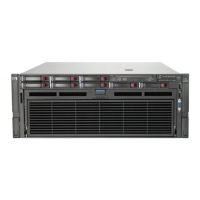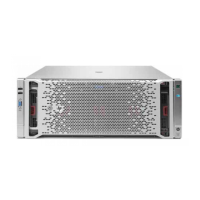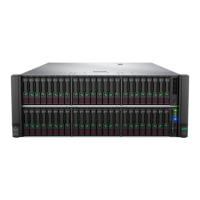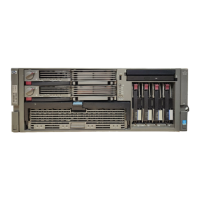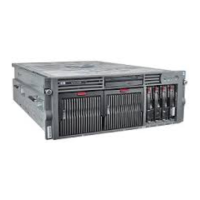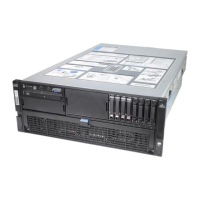68 HP ProLiant DL580 Generation 3 Server Maintenance and Service Guide
The following guidelines apply to hot-plug mirrored memory:
• All general memory requirements apply ("General memory configuration
requirements" on page 62
).
• Hot-plug mirrored memory is supported with two or four memory boards.
• Memory boards 1 and 2 are populated for dual-board hot-plug mirrored
memory. Boards 1, 2, 3, and 4 are populated for quad-board hot-plug
mirrored memory. Any deviation from these guidelines results in the server
defaulting to Advanced ECC ("Advanced ECC memory" on page 64
).
• Memory boards 1 and 2 form a mirrored pair for dual-board hot-plug
mirrored memory. For quad-board hot-plug mirrored memory, memory
boards 3 and 4 also form a mirrored pair.
• Memory boards within a mirrored pair must have the same amount of total
memory. However, each board of the mirrored pair may have different
DIMM configurations as long as they have equal total size. For example,
memory boards 1 and 2 could each contain 2 GB of physical memory per
board with board 1 containing two 1-GB DIMMs and board 2 containing
four 512-MB DIMMs.
• The amount of memory between mirrored pairs can be different in quad-
board Hot-Plug Mirrored Memory mode. For example, memory pair 1
(boards 1 and 2) can contain 2 GB each while memory pair 2 (boards 3 and
4) contain 4 GB each.
• In quad-board hot-plug mirrored memory, the two pairs of memory boards
operate independently. One of the pairs of memory boards can be degraded
while the other pair of memory boards can still be fully mirrored.
• Hot-add operations are not supported. Board removals and insertions in Hot-
Plug Mirrored Memory mode are solely for the purpose of hot-replace
operations.
• For hot-replace to function properly, the memory board must be re-inserted
into the location from which it was removed. If the board is placed into the
incorrect slot (for example, if board 2 is removed in dual-board mode and re-
inserted into memory slots 3 or 4), a configuration error occurs. Attempting
to insert a board into the improper position results in audio alarms and visual
alerts.
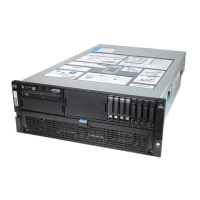
